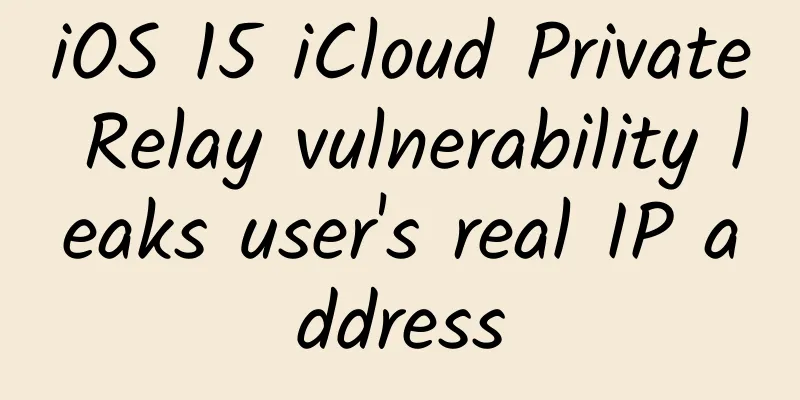iOS 15 iCloud Private Relay vulnerability leaks user's real IP address

|
The iCloud private relay service vulnerability introduced in Apple iOS 15 caused the user's real IP address to be leaked. iCloud Private Relay service is a new feature introduced in Apple's iOS 15 beta, which allows users to browse the Internet in a more secure and private way through the Safari browser. The service ensures that the traffic leaving the device is encrypted, and uses 2 Internet relays to allow users to browse the Internet without using their real IP address and location. Client IP address leaks using iCloud Private RelayFingerprintJS security researchers found that users can obtain the proxy's IP address through HTTP requests received by the server. The real IP address of the client can also be obtained through webRTC. WebRTC (web real-time communication) is an open source project that aims to provide real-time communication for web browsers and mobile applications through APIs, which can achieve point-to-point audio and video communication without installing plug-ins or apps. The real-time media information exchange between two terminals is established through a discovery and negotiation process called signaling. A framework called interactive connectivity establishment (ICE) is used in signaling. There are two methods in the framework that can be used to find and establish connections. FingerprintJS researchers found that when data needs to be transmitted between terminals through the NAT (Network Address Translation) protocol, the STUN server will generate a "Server Reflexive Candidate". STUN is a tool used to extract the public IP address and port number of the network device behind NAT. The vulnerability stems from the fact that STUN requests are not proxied through iCloud Private Relay, which will cause the client's real IP address to be exposed when ICE candidates are exchanged during the signaling process. FingerprintJS said it has reported the security vulnerability to Apple, and Apple has fixed it in the latest version of macOS Monterey. However, it is still not fixed in iOS 15 system using iCloud Private Relay. This issue shows that iCloud Private Relay cannot replace a virtual network. Users who want to hide their real IP address should still consider using a virtual network or browsing the Internet through Tor, and use JS to turn off WebRTC-related features when using the Safari browser. For full technical details, see: https://fingerprintjs.com/blog/ios15-icloud-private-relay-vulnerability/ This article is translated from: https://thehackernews.com/2021/09/apples-new-icloud-private-relay-service.html. If reprinted, please indicate the original address. |
<<: iFixit shares iPhone 13 Pro disassembly report: repairability is only 5/10 points
Recommend
The "aging but not aging" brain: Your cognitive function has not reached its peak at the age of 70
Written by: Liu Fang Editor: Kou Jianchao Layout:...
How to solve the low conversion rate? Here are 5 tips!
The operational goal of our service account is to...
Wuhan allows residents of communities without epidemic conditions to move around in batches! Can production be resumed? Attached is the original notice
The epidemic situation in Wuhan has been brought ...
Samsung, LG and other Korean battery manufacturers increase investment in China: targeting the new energy vehicle industry
According to BusinessKorea Beijing time on May 5,...
Five essential data analysis methods for data operations
Last time we talked about how, when locking in th...
Is the new coronavirus a "super mutation"? A picture to understand "Omicron"
Recently, the new coronavirus variant "Omicr...
The world's largest! The glass ball in the Greater Bay Area that explores the beginning of the universe is fully built!
Author: Li Chuanfu Shi Xiangqi On October 11, 202...
Tencent QQ Mini Program was blocked and suspended on WeChat: Violation of regulations
On the evening of March 11, some media found that...
Teach you how to create explosive short videos and easily monetize them
01 Changes in the communication model: From manua...
Tesla has 1,045 super charging stations around the world, but Didi drivers are not welcome to use them
From a certain perspective, as the world's mo...
How to plan creative materials for high-conversion information flow ads? Avoid these 4 mistakes!
Before talking about what is good information flo...
Konka YIUI 7.0 can better understand your experience of owning a smart TV.
Smart home appliances are a major trend in the cu...
Is Apple blocking third-party batteries out of genuine consideration for users, or is it overbearing marketing?
Apple phones are probably the hottest stars in th...
[Yingtu Ma] Chenlu Ancient Style National Trend 7th Commercial Illustration Course will end in February 2021 [High-definition picture quality with brush courseware]
Yingtu Ma] Chenlu Ancient Style National Trend 7t...
US user tests iPhone 6 panel: no trace left even after being scratched by a knife
Beijing time, July 8 morning news, YouTube user M...









